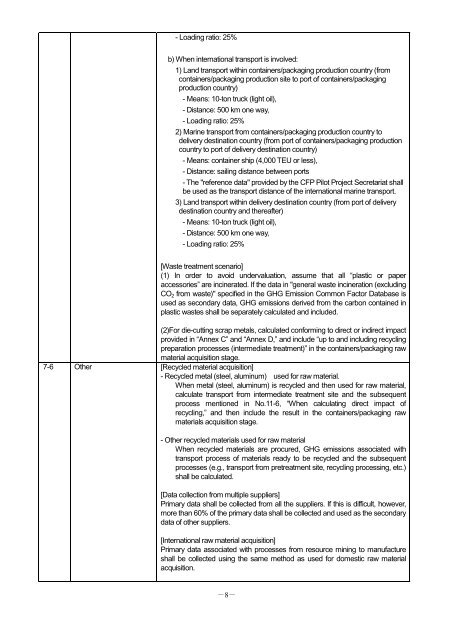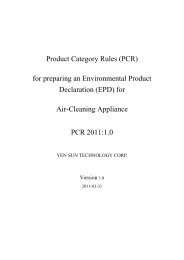Download(PDF) - PCR Library
Download(PDF) - PCR Library
Download(PDF) - PCR Library
Create successful ePaper yourself
Turn your PDF publications into a flip-book with our unique Google optimized e-Paper software.
- Loading ratio: 25%<br />
b) When international transport is involved:<br />
1) Land transport within containers/packaging production country (from<br />
containers/packaging production site to port of containers/packaging<br />
production country)<br />
- Means: 10-ton truck (light oil),<br />
- Distance: 500 km one way,<br />
- Loading ratio: 25%<br />
2) Marine transport from containers/packaging production country to<br />
delivery destination country (from port of containers/packaging production<br />
country to port of delivery destination country)<br />
- Means: container ship (4,000 TEU or less),<br />
- Distance: sailing distance between ports<br />
- The "reference data" provided by the CFP Pilot Project Secretariat shall<br />
be used as the transport distance of the international marine transport.<br />
3) Land transport within delivery destination country (from port of delivery<br />
destination country and thereafter)<br />
- Means: 10-ton truck (light oil),<br />
- Distance: 500 km one way,<br />
- Loading ratio: 25%<br />
[Waste treatment scenario]<br />
(1) In order to avoid undervaluation, assume that all “plastic or paper<br />
accessories” are incinerated. If the data in "general waste incineration (excluding<br />
CO2 from waste)" specified in the GHG Emission Common Factor Database is<br />
used as secondary data, GHG emissions derived from the carbon contained in<br />
plastic wastes shall be separately calculated and included.<br />
(2)For die-cutting scrap metals, calculated conforming to direct or indirect impact<br />
provided in “Annex C” and “Annex D,” and include “up to and including recycling<br />
preparation processes (intermediate treatment)” in the containers/packaging raw<br />
material acquisition stage.<br />
7-6 Other [Recycled material acquisition]<br />
- Recycled metal (steel, aluminum) used for raw material.<br />
When metal (steel, aluminum) is recycled and then used for raw material,<br />
calculate transport from intermediate treatment site and the subsequent<br />
process mentioned in No.11-6, “When calculating direct impact of<br />
recycling,” and then include the result in the containers/packaging raw<br />
materials acquisition stage.<br />
- Other recycled materials used for raw material<br />
When recycled materials are procured, GHG emissions associated with<br />
transport process of materials ready to be recycled and the subsequent<br />
processes (e.g., transport from pretreatment site, recycling processing, etc.)<br />
shall be calculated.<br />
[Data collection from multiple suppliers]<br />
Primary data shall be collected from all the suppliers. If this is difficult, however,<br />
more than 60% of the primary data shall be collected and used as the secondary<br />
data of other suppliers.<br />
[International raw material acquisition]<br />
Primary data associated with processes from resource mining to manufacture<br />
shall be collected using the same method as used for domestic raw material<br />
acquisition.<br />
-8-















